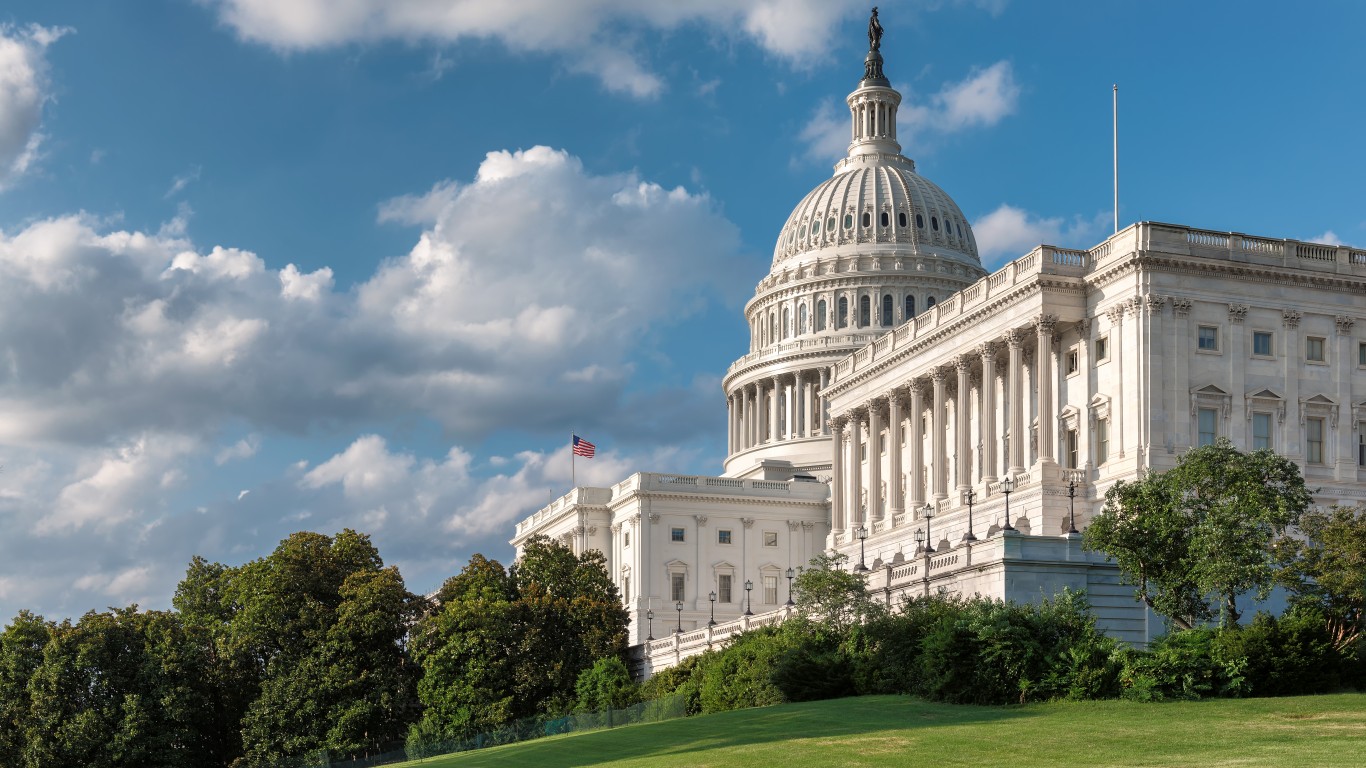Special Report
States Getting the Most and Least From Uncle Sam

Published:
Last Updated:

Every year, workers in all 50 states fill out their 1040 form to pay taxes to the federal government. That money does not necessarily stay in Washington, however. The federal government generates revenue from sources like income and employment taxes and redistributes it based on need. And not all states benefit equally.
The total amount the federal government collected from each state in the 2017 fiscal year ranged from $5.6 billion from Vermont to $435.6 billion from California. The majority of states — including Vermont and California — ultimately get more money back than they contribute. Money from the federal government is redistributed back to states in the form of grants, aid programs for the needy, and payments to major government contracting firms such as defense companies.
A recent report from public policy think tank the Rockefeller Institute of Government titled “Giving or Getting? New York’s Balance of Payments with the Federal Government,” highlights the differences in what states give to the federal government compared to what they receive. 24/7 Wall St. reviewed the report in addition to Census data to identify the states getting the most and least from Uncle Sam. States were ranked based on the amount of money they received per capita from the federal government in fiscal 2017 minus the amount residents and organizations paid the federal government per capita.
The states receiving the most from Washington on a per capita basis tend have relatively large poor populations that depend on federal assistance programs like SNAP (formerly known as food stamps) and Medicaid. On the flip side, the states that give more to the federal government than they receive tend to have higher income residents. Exceptions include states like Maryland and Virginia, which, though they are wealthier states, also benefit from disproportionately high federal funding partly due to their large defense contracting sectors.
Click here to see the states getting the most and least from the federal government.
Click here to read our methodology.

1. Virginia
> Net federal funding: $10,301 per resident
> Total revenue from fed. gov.: $176.8 billion (5th most)
> SNAP benefit recipiency: 8.1% (8th lowest)
> Median household income: $71,535 (9th highest)
[in-text-ad]

2. Kentucky
> Net federal funding: $9,145 per resident
> Total revenue from fed. gov.: $70.8 billion (19th most)
> SNAP benefit recipiency: 14.1% (8th highest)
> Median household income: $48,375 (7th lowest)

3. New Mexico
> Net federal funding: $8,692 per resident
> Total revenue from fed. gov.: $31.7 billion (19th least)
> SNAP benefit recipiency: 17.4% (the highest)
> Median household income: $46,744 (5th lowest)

4. West Virginia
> Net federal funding: $7,283 per resident
> Total revenue from fed. gov.: $24.6 billion (15th least)
> SNAP benefit recipiency: 16.8% (2nd highest)
> Median household income: $43,469 (the lowest)
[in-text-ad-2]

5. Alaska
> Net federal funding: $7,048 per resident
> Total revenue from fed. gov.: $13.0 billion (8th least)
> SNAP benefit recipiency: 10.8% (tied – 22nd lowest)
> Median household income: $73,181 (7th highest)

6. Mississippi
> Net federal funding: $6,880 per resident
> Total revenue from fed. gov.: $37.8 billion (21st least)
> SNAP benefit recipiency: 15.3% (6th highest)
> Median household income: $43,529 (2nd lowest)
[in-text-ad]

7. Alabama
> Net federal funding: $6,694 per resident
> Total revenue from fed. gov.: $65.8 billion (21st most)
> SNAP benefit recipiency: 14.0% (9th highest)
> Median household income: $48,123 (6th lowest)

8. Maryland
> Net federal funding: $6,035 per resident
> Total revenue from fed. gov.: $105.1 billion (11th most)
> SNAP benefit recipiency: 10.3% (17th lowest)
> Median household income: $80,776 (the highest)

9. Maine
> Net federal funding: $5,572 per resident
> Total revenue from fed. gov.: $17.4 billion (10th least)
> SNAP benefit recipiency: 12.8% (17th highest)
> Median household income: $56,277 (20th lowest)
[in-text-ad-2]

10. Hawaii
> Net federal funding: $5,270 per resident
> Total revenue from fed. gov.: $19.9 billion (13th least)
> SNAP benefit recipiency: 10.7% (20th lowest)
> Median household income: $77,765 (3rd highest)

11. Arkansas
> Net federal funding: $5,080 per resident
> Total revenue from fed. gov.: $35.1 billion (20th least)
> SNAP benefit recipiency: 11.8% (25th highest)
> Median household income: $45,869 (3rd lowest)
[in-text-ad]

12. South Carolina
> Net federal funding: $5,008 per resident
> Total revenue from fed. gov.: $59.7 billion (23rd most)
> SNAP benefit recipiency: 12.3% (tied – 19th highest)
> Median household income: $50,570 (9th lowest)

13. Arizona
> Net federal funding: $4,430 per resident
> Total revenue from fed. gov.: $82.8 billion (14th most)
> SNAP benefit recipiency: 10.8% (tied – 22nd lowest)
> Median household income: $56,581 (23rd lowest)

14. Oklahoma
> Net federal funding: $3,986 per resident
> Total revenue from fed. gov.: $45.1 billion (23rd least)
> SNAP benefit recipiency: 13.2% (tied – 12th highest)
> Median household income: $50,051 (8th lowest)
[in-text-ad-2]

15. Missouri
> Net federal funding: $3,949 per resident
> Total revenue from fed. gov.: $72.3 billion (18th most)
> SNAP benefit recipiency: 11.0% (23rd lowest)
> Median household income: $53,578 (15th lowest)

16. Montana
> Net federal funding: $3,808 per resident
> Total revenue from fed. gov.: $12.2 billion (6th least)
> SNAP benefit recipiency: 9.4% (14th lowest)
> Median household income: $53,386 (14th lowest)
[in-text-ad]

17. Louisiana
> Net federal funding: $3,785 per resident
> Total revenue from fed. gov.: $52.0 billion (25th least)
> SNAP benefit recipiency: 16.4% (3rd highest)
> Median household income: $46,145 (4th lowest)

18. Vermont
> Net federal funding: $3,741 per resident
> Total revenue from fed. gov.: $8.0 billion (3rd least)
> SNAP benefit recipiency: 11.5% (24th lowest)
> Median household income: $57,513 (24th lowest)

19. Tennessee
> Net federal funding: $3,591 per resident
> Total revenue from fed. gov.: $76.3 billion (17th most)
> SNAP benefit recipiency: 13.5% (11th highest)
> Median household income: $51,340 (10th lowest)
[in-text-ad-2]

20. Idaho
> Net federal funding: $3,428 per resident
> Total revenue from fed. gov.: $17.5 billion (11th least)
> SNAP benefit recipiency: 9.7% (16th lowest)
> Median household income: $52,225 (11th lowest)

21. North Carolina
> Net federal funding: $3,358 per resident
> Total revenue from fed. gov.: $113.1 billion (9th most)
> SNAP benefit recipiency: 12.3% (tied – 19th highest)
> Median household income: $52,752 (13th lowest)
[in-text-ad]

22. Delaware
> Net federal funding: $2,892 per resident
> Total revenue from fed. gov.: $11.5 billion (5th least)
> SNAP benefit recipiency: 10.4% (18th lowest)
> Median household income: $62,852 (17th highest)

23. Ohio
> Net federal funding: $2,750 per resident
> Total revenue from fed. gov.: $125.7 billion (8th most)
> SNAP benefit recipiency: 13.2% (tied – 12th highest)
> Median household income: $54,021 (16th lowest)

24. Oregon
> Net federal funding: $2,477 per resident
> Total revenue from fed. gov.: $45.7 billion (24th least)
> SNAP benefit recipiency: 15.4% (tied – 4th highest)
> Median household income: $60,212 (20th highest)
[in-text-ad-2]

25. Michigan
> Net federal funding: $2,474 per resident
> Total revenue from fed. gov.: $108.4 billion (10th most)
> SNAP benefit recipiency: 13.1% (14th highest)
> Median household income: $54,909 (18th lowest)

26. Indiana
> Net federal funding: $2,359 per resident
> Total revenue from fed. gov.: $67.8 billion (20th most)
> SNAP benefit recipiency: 9.3% (13th lowest)
> Median household income: $54,181 (17th lowest)
[in-text-ad]

27. Pennsylvania
> Net federal funding: $2,299 per resident
> Total revenue from fed. gov.: $155.8 billion (6th most)
> SNAP benefit recipiency: 12.9% (tied – 15th highest)
> Median household income: $59,195 (24th highest)

28. Georgia
> Net federal funding: $2,253 per resident
> Total revenue from fed. gov.: $104.5 billion (12th most)
> SNAP benefit recipiency: 12.6% (18th highest)
> Median household income: $56,183 (19th lowest)

29. Rhode Island
> Net federal funding: $2,228 per resident
> Total revenue from fed. gov.: $12.6 billion (7th least)
> SNAP benefit recipiency: 15.4% (tied – 4th highest)
> Median household income: $63,870 (15th highest)
[in-text-ad-2]

30. Florida
> Net federal funding: $2,187 per resident
> Total revenue from fed. gov.: $237.7 billion (3rd most)
> SNAP benefit recipiency: 13.6% (10th highest)
> Median household income: $52,594 (12th lowest)

31. Kansas
> Net federal funding: $1,983 per resident
> Total revenue from fed. gov.: $31.3 billion (18th least)
> SNAP benefit recipiency: 7.7% (6th lowest)
> Median household income: $56,422 (21st lowest)
[in-text-ad]

32. South Dakota
> Net federal funding: $1,409 per resident
> Total revenue from fed. gov.: $9.3 billion (4th least)
> SNAP benefit recipiency: 8.9% (tied – 12th lowest)
> Median household income: $56,521 (22nd lowest)

33. Nevada
> Net federal funding: $1,140 per resident
> Total revenue from fed. gov.: $28.7 billion (16th least)
> SNAP benefit recipiency: 12.2% (22nd highest)
> Median household income: $58,003 (25th lowest)

34. Iowa
> Net federal funding: $1,105 per resident
> Total revenue from fed. gov.: $29.9 billion (17th least)
> SNAP benefit recipiency: 9.6% (15th lowest)
> Median household income: $58,570 (25th highest)
[in-text-ad-2]

35. Minnesota
> Net federal funding: $959 per resident
> Total revenue from fed. gov.: $64.4 billion (22nd most)
> SNAP benefit recipiency: 7.8% (7th lowest)
> Median household income: $68,388 (12th highest)

36. Wyoming
> Net federal funding: $670 per resident
> Total revenue from fed. gov.: $7.1 billion (the least)
> SNAP benefit recipiency: 6.3% (tied – the lowest)
> Median household income: $60,434 (19th highest)
[in-text-ad]

37. Wisconsin
> Net federal funding: $536 per resident
> Total revenue from fed. gov.: $55.4 billion (25th most)
> SNAP benefit recipiency: 10.6% (19th lowest)
> Median household income: $59,305 (22nd highest)

38. Texas
> Net federal funding: $304 per resident
> Total revenue from fed. gov.: $269.0 billion (2nd most)
> SNAP benefit recipiency: 12.0% (tied – 23rd highest)
> Median household income: $59,206 (23rd highest)

39. Utah
> Net federal funding: $296 per resident
> Total revenue from fed. gov.: $23.9 billion (14th least)
> SNAP benefit recipiency: 6.8% (3rd lowest)
> Median household income: $68,358 (13th highest)
[in-text-ad-2]

40. California
> Net federal funding: $12 per resident
> Total revenue from fed. gov.: $436.1 billion (the most)
> SNAP benefit recipiency: 8.9% (tied – 12th lowest)
> Median household income: $71,805 (8th highest)

41. Colorado
> Net federal funding: -$95 per resident
> Total revenue from fed. gov.: $57.5 billion (24th most)
> SNAP benefit recipiency: 7.6% (5th lowest)
> Median household income: $69,117 (11th highest)
[in-text-ad]

42. Nebraska
> Net federal funding: -$164 per resident
> Total revenue from fed. gov.: $17.7 billion (12th least)
> SNAP benefit recipiency: 8.3% (9th lowest)
> Median household income: $59,970 (21st highest)

43. Washington
> Net federal funding: -$184 per resident
> Total revenue from fed. gov.: $80.5 billion (15th most)
> SNAP benefit recipiency: 12.3% (tied – 19th highest)
> Median household income: $70,979 (10th highest)

44. New Hampshire
> Net federal funding: -$234 per resident
> Total revenue from fed. gov.: $15.0 billion (9th least)
> SNAP benefit recipiency: 7.0% (4th lowest)
> Median household income: $73,381 (6th highest)
[in-text-ad-2]

45. Illinois
> Net federal funding: -$364 per resident
> Total revenue from fed. gov.: $131.8 billion (7th most)
> SNAP benefit recipiency: 12.9% (tied – 15th highest)
> Median household income: $62,992 (16th highest)

46. North Dakota
> Net federal funding: -$720 per resident
> Total revenue from fed. gov.: $7.9 billion (2nd least)
> SNAP benefit recipiency: 6.3% (tied – the lowest)
> Median household income: $61,843 (18th highest)
[in-text-ad]

47. New York
> Net federal funding: -$1,792 per resident
> Total revenue from fed. gov.: $220.6 billion (4th most)
> SNAP benefit recipiency: 14.8% (7th highest)
> Median household income: $64,894 (14th highest)

48. Massachusetts
> Net federal funding: -$2,343 per resident
> Total revenue from fed. gov.: $78.7 billion (16th most)
> SNAP benefit recipiency: 11.7% (25th lowest)
> Median household income: $77,385 (4th highest)

49. New Jersey
> Net federal funding: -$2,368 per resident
> Total revenue from fed. gov.: $97.7 billion (13th most)
> SNAP benefit recipiency: 8.9% (tied – 12th lowest)
> Median household income: $80,088 (2nd highest)
[in-text-ad-2]

50. Connecticut
> Net federal funding: -$4,000 per resident
> Total revenue from fed. gov.: $41.1 billion (22nd least)
> SNAP benefit recipiency: 12.0% (tied – 23rd highest)
> Median household income: $74,168 (5th highest)
Methodology
To identify the states getting the most and least from the federal government, 24/7 Wall St. reviewed the “Giving or Getting? New York’s Balance of Payments with the Federal Government” report from the Rockefeller Institute of Government. States were ranked based on the amount of money they received per capita from the federal government in fiscal 2017 minus the amount residents and organizations paid the federal government per capita. SNAP benefit recipiency and median household income are 2017 estimates from the U.S. Census Bureau’s American Community Survey.
Retirement can be daunting, but it doesn’t need to be.
Imagine having an expert in your corner to help you with your financial goals. Someone to help you determine if you’re ahead, behind, or right on track. With SmartAsset, that’s not just a dream—it’s reality. This free tool connects you with pre-screened financial advisors who work in your best interests. It’s quick, it’s easy, so take the leap today and start planning smarter!
Don’t waste another minute; get started right here and help your retirement dreams become a retirement reality.
Thank you for reading! Have some feedback for us?
Contact the 24/7 Wall St. editorial team.